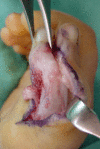Prognostic value of age and Wassel classification in the reconstruction of thumb duplication
- PMID: 24432120
- PMCID: PMC3886344
- DOI: 10.1007/s11832-013-0534-3
Prognostic value of age and Wassel classification in the reconstruction of thumb duplication
Abstract
Background: Various surgical techniques for thumb duplication have been described. The main goal in thumb reconstruction is to achieve optimal function, stability, and shape. Few publications have quantified the functional results of each surgical option and factors that may affect these outcomes.
Methods: We performed a retrospective review during the period from 1990 to 2011 of 115 surgery patients, 99 of whom had a mean postoperative follow-up of 44.1 months. They were classified according to the Wassel classification. We assessed the surgical technique, functional results, and complications, and evaluated the probable prognostic value of age and Wassel classification.
Results: This case series comprised mainly female patients (62 %) and the right hand (74 %), with a mean age at operation of 20 months. The most common group was Wassel type IV (54 %). On the basis of the Tada scoring system, we obtained 91 good results (91 %). Complications occurred in 27 patients (27 %), mainly instability and axis deformation. In a comparison of preoperative factors (age at the time of surgery and Wassel classification) with the final results (Tada score and complications), the association between older age at surgery and complications (p = 0.0001) and Wassel types III and IV and complications (p = 0.0210 and p = 0.0095) was statistically significant.
Conclusions: Following the basic concepts of anatomical reconstruction, we obtained good results in most patients. The main complications were instability and axial deformity. These were most common in patients who underwent operations at an age of more than 12 months, and patients with Wassel types III and IV deformities.
Keywords: Hand reconstructive surgery; Polydactyly; Prognostic value; Tada score; Thumb duplication; Wassel classification.
Figures
Similar articles
-
Thumb polydactyly: clinical outcome after reconstruction.J Orthop Surg (Hong Kong). 2006 Dec;14(3):295-302. doi: 10.1177/230949900601400312. J Orthop Surg (Hong Kong). 2006. PMID: 17200532
-
Secondary complications in Wassel II & IV thumb duplication: a comprehensive review of preventive measures.Hand Surg Rehabil. 2024 Apr;43(2):101642. doi: 10.1016/j.hansur.2024.101642. Epub 2024 Jan 11. Hand Surg Rehabil. 2024. PMID: 38215882 Review.
-
[Optimal surgical timing and treatment of thumb duplication in children].Zhonghua Zheng Xing Wai Ke Za Zhi. 2013 Sep;29(5):336-40. Zhonghua Zheng Xing Wai Ke Za Zhi. 2013. PMID: 24409773 Chinese.
-
Surgical reconstruction in Wassel type IV thumb duplication.Acta Orthop Traumatol Turc. 2014;48(2):181-6. doi: 10.3944/AOTT.2014.13.0042. Acta Orthop Traumatol Turc. 2014. PMID: 24747627
-
Radial Polydactyly. What's New?Curr Pediatr Rev. 2018;14(2):91-96. doi: 10.2174/1573396314666180124102012. Curr Pediatr Rev. 2018. PMID: 29366421 Review.
Cited by
-
Modified method for reconstruction of thumb abduction function in children undergoing surgical treatment of thumb duplication.J Child Orthop. 2021 Apr 19;15(2):97-105. doi: 10.1302/1863-2548.15.200197. J Child Orthop. 2021. PMID: 34040655 Free PMC article.
-
An unusual presentation of pacifier thumb duplication with VACTERL association: Case report and review of literature.Int J Surg Case Rep. 2024 Sep;122:110090. doi: 10.1016/j.ijscr.2024.110090. Epub 2024 Jul 27. Int J Surg Case Rep. 2024. PMID: 39142182 Free PMC article.
-
Epidemiological characteristics and distribution of congenital thumb duplication in south China: An analysis of 2,300 thumbs in 2,108 children.Front Pediatr. 2022 Nov 2;10:1027243. doi: 10.3389/fped.2022.1027243. eCollection 2022. Front Pediatr. 2022. PMID: 36405832 Free PMC article.
-
Retinoblastoma and polydactyly in a child with 46, XY, 15pstk+ karyotype-A case report and literature review.Mol Genet Genomic Med. 2024 Mar;12(3):e2414. doi: 10.1002/mgg3.2414. Mol Genet Genomic Med. 2024. PMID: 38465842 Free PMC article. Review.
-
Letter to the Editor regarding "Prognostic value of age and Wassel classification in the reconstruction of thumb duplication".J Child Orthop. 2014 May;8(3):289-90. doi: 10.1007/s11832-014-0591-2. Epub 2014 May 13. J Child Orthop. 2014. PMID: 24820625 Free PMC article. No abstract available.
References
-
- Yen CH, Chan WL, Leung HB, et al. Thumb polydactyly: clinical outcome after reconstruction. J Orthop Surg (Hong Kong) 2006;14(3):295–302. - PubMed
-
- Ezaki M. Radial polydactyly. Hand Clin. 1990;6(4):577–588. - PubMed
-
- Watson BT, Hennrikus WL. Postaxial type-B polydactyly. Prevalence and treatment. J Bone Joint Surg Am. 1997;79:65–68. - PubMed
-
- Graham TJ, Ress AM. Finger polydactyly. Hand Clin. 1998;14:49–64. - PubMed
LinkOut - more resources
Full Text Sources
Other Literature Sources




